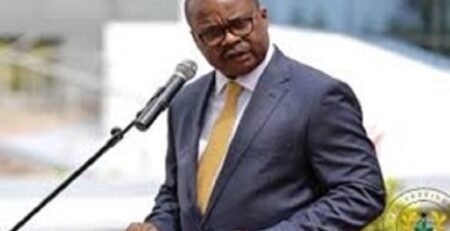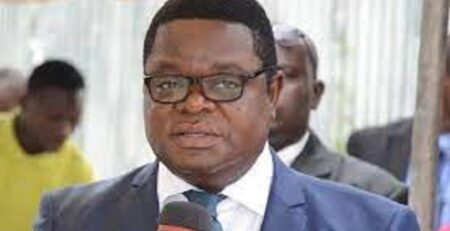Receiver for collapsed 347 MFIs turns to property auctions this week
Properties belonging to the collapsed 347 Microfinance Companies (“MFIs”) and the 23 Savings & Loans and Finance House Companies will from Monday, March 8 be auctioned the Receiver of the collapsed financial institution, Eric Nana Nipah has disclosed. This is the latest move in the effort to recover a major part of the value of assets owned by the capital deficient and consequently liquidated financial intermediaries so as to refund government which has borrowed money to pay off their depositors.
So far government has borrowed close to GHc20 billion to issue financial resolution bonds which have been used to refund deposits lost to the liquidated institutions. While the largest chunk of this has been used to refund deposits held in liquidated commercial banks, the smaller financial intermediation companies – primarily savings and loans companies and microfinance institutions – have a large number of retail depositors who are most vulnerable to a loss of their deposits. Less than GHc3 billion has gone into paying off the depositors of MFI s but the refund process itself has proved controversial because a lot of claims have been rejected on the grounds of insufficient documentary proof. While some of the rejected claims were indeed fraudulent there certainly have been some genuine depositors that have lost out for documentary and legal reasons.
Most of such deposits have been paid with monies borrowed by government but this has substantially increased the public debt; financial resolution bonds issued are equivalent to some five percent of Gross Domestic Product and thus have been pivotal in taking Ghana’s public debt to GDP ratio over the generally accepted debt sustainability ration of 70 percent. The ratio is estimated to have exceeded 75 percent by the end of 2020 and this has major implications for Ghana’s sovereign credit worthiness.
However government’s hopes of recovering most of its money through asset recoveries have been largely dashed through a combination of slow judicial processes and the realization that most of the affected institutions had overstated the value of their assets.
As at the middle of last year, according to the receiver for the 347 microfinance companies, 23 savings and loans companies and the 39 micro-credit companies, GHc598 million had been recovered out of the targeted assets of GHc2.9 billion. Updated statistics on this, as at the end of 2020 have not yet been made public. On the upside, as time goes back the receiver gets closer to recovering assets whose recoveries have been held up by the slow wheels of the judicial process. But on the downside, point out industry analysts, the proverbial low lying fruits – that is the assets most easily identified and subsequently recovered – are already in the public kitty; those left are those that are proving problematic to recover.
The amount was recouped from loan recoveries (GH¢44 million), placements and investments (GH¢495 million), balances transferred from other banks (GH¢50 million), sale of vehicles (GH¢4 million) and cash in vault (GH¢5 million).
Eric Nana Nipah, has attributed the low level of recoveries to the poor quality of assets of some of the institutions, diversion of assets to other institutions or to personal ownership in order to hide them from the authorities, and the earlier misstatement of a significant proportion of declared assets by some of the liquidated companies.
Some of the institutions do not have records of their assets at all, and for some of them, we do not even have records to validate depositors claims” Nipah lamented last year. “Another reason is that some of the assets identified are encumbered – they had been used by some of the institutions as collateral and security for monies taken from other institutions.”
Consequently the receiver last year made a report to the Economic and Organized Crimes Office to help with the tracing of assets of the affected institutions.
“We have involved EOCO in the tracing of assets and EOCO has done some good work in this area, where they have been able to trace some assets of these institutions” confirms Nipah. “We forwarded the list of the top 10 institutions from whom we have received the highest claims from depositors to EOCO and asked it to do some investigations to trace the assets of those institutions.”
But recovering most of the assets has proved to be an uphill task. Most of the liquidated institutions had been lying to the regulator, the BoG long before their licenses were revoked in an effort to deceive the central bank into believing they were still solvent. For instance, some institutions claimed to have made numerous fund placements with other institutions which turned out to be fictitious. The fact that many of the institutions where such funds were claimed to have been placed were equally financially distressed and ultimately shut down has made the unraveling of the resultant mess all the harder as proper records were not kept by either purported counterparty.
A major part of the problem has been the BoG’s grossly inadequate regulatory capacity, which the central bank has repeatedly denied. MFIs and micro-credit firms in particular have been located in rural areas where the BoG has no representation.
This, plus the sheer number of such institutions and their branches has made it impossible for the regulator to carry out regular on-site inspections as required by regulatory best practice. Thus, these institutions were able to hide their financial shortfalls for years, sending the BoG false reports to meet their off-site reporting obligations. It was only when the repeated failure of such institutions to meet their obligations to depositors and fund placement counterparties were brought to the central bank’s notice that it belatedly spared the staff to hold on-site inspections.
Even then on-site inspections did not reveal the real situation of some institutions as BoG inspectors failed to report back the true depth of their insolvency, rather collaborating with the culprit institutions to hide the truth.
Furthermore, initially, the BoG’s reaction time to suspocions of dubious reporting was poor. For example it took the BoG about six months to organize an on-site inspection of DKM Microfinance after it realized that the company’s off-site reports must have been fake since it was claiming that monies taken from depositors at close to 20 percent per month were being placed with commercial banks as fixed deposits which were giving interest rates that effectively translated to less than two percent a month.
Actually, much of the deposits taken were being invested in the institutions own trading activities. A lot more was being used to set up going concerns which were ostensibly subsidiaries of the deposit taking MFIs. Indeed this is what eventually informed the corporate governance directives instituted by the BoG in April 2018 restraining inter-connected lending.
But while such monies can be traced – although not recovered since ultimately such investments produced more losses than profits – the biggest evaporation of deposits has occurred through the diversion of such deposits away from the deposit taking MFIs altogether into the hands of their owners and managers. Retracing such malfeasance has proved extremely difficult since the culprits have most often used third parties – family members and friends – as fronts to receive the diverted funds. Thus a deposit placed with an MFI would end up in the form of a property purchased by the family member or friend of one of its owners. Even where the movement of such funds can be ascertained, proving it to the standards required by law is a much larger proposition and so the ultimate result has often been court injunctions preventing the receiver from confiscating properties identified as having been purchased with deposits placed with an MFI.
At the same time therefore, the receiver has adopted the strategy of public auction of physical assets of the institutions to narrow the huge gap between the target for recoveries and what was actually being recovered. Although, data has not been made value on the targets and outcomes for auctions, it is unlikely they can make up anywhere near the overall shortfalls being suffered.
The first round of auctions took place last year, between Monday February 3 and Friday February 7. A batch of used cars and motor bikes were sold
The impending auction of institutional properties is expected to enable government recoup a small part of the value locked up.
A statement by the receiver indicated that a consortium of auctioneers Wildos Mart, Broadway Mart, and Yakamata Mart has been appointed to conduct the auction.
The statement added that “the sale of the chattels of the resolved MFIs and S&Ls will be conducted at the respective branches of the resolved MFIs and 23 S&Ls across the 16 regions from Monday, March 8, 2021 until all items are sold out.
“Chattels to be auctioned include air conditioners – split/window, desk-top computers, fridges, water dispensers, swivel chairs, executive office tables/chairs, leather sofas, couches, flat-screen television sets and generators.”
However industry analysts point out that most of the physical assets that could enable government recoup substantial value are now held in individual hands of owners and top managers of the liquidated institutions who had diverted corporate funds, including customer deposits to acquire them. But recovering them will prove difficult since it must be proved that such assets were acquired through financial malfeasance and much of such assets are now held by fronts making it difficult to trace the origins of the funds used to acquire them.
It is still unclear whether more asset recoveries will translate into more deposit refunds although this is looking increasingly unlikely for several reasons. One is that all properly documented claims have been paid already either by cash or in the form of bonds. A second is that government’s deteriorating fiscal situation will persuade it to hold on to the proceeds of further asset recoveries, either to pay down part of the debt taken to pay off depositors who already have been settled or simply to support the financing of the 2021 budget which will have a fiscal deficit of close to nine percent of GDP that has to be financed. The third reason is that with a 2020 general elections victory already under its belt the political exigencies that convinced government to refund depositors in the first place no longer apply. Simply put, depositors who still have outstanding claims are no longer in a position to threaten to withhold their votes as a means of securing government’s acquiescence.
The central bank on Friday, May 31, 2019, announced that it had revoked the licenses of some 347 microfinance institutions in the country.
It also took similar action against some 39 microcredit institutions operating in Ghana.
A statement from the central bank said some of the institutions were insolvent while others had been out of operation for some time now.
Source:Goldstreet Business














Leave a Reply